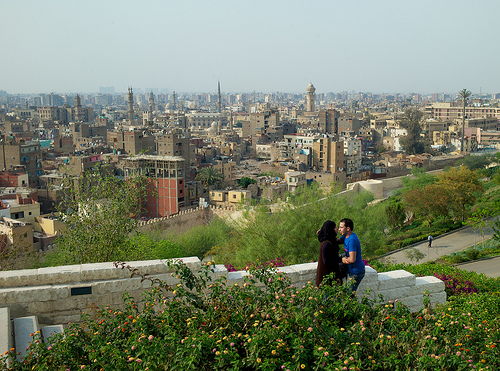A biweekly newsletter with public space news, resources, and opportunities.
A curated dispatch on all things public markets plus the latest announcements from the Market Cities Program.
If any city has proven the importance of public space in the last year, it’s Cairo, where Tahrir Square became a vital gathering place for protesters determined to overthrow the government — as well as an international symbol of the desire for freedom and democracy. The Arab Spring may have been organized in great part online, but it was in the city’s public spaces that the people took action that could not be ignored and brought about radical change.

And it wasn’t just Tahrir Square or the boulevards of central Cairo that played a role. It was the streets of residential neighborhoods as well.
Back in July, PPS’s Cynthia Nikitin visited Cairo for the UN’s Designing Safe Cities with Women and Girls stakeholder planning meeting (the trip was part of our partnership with UN-HABITAT). While she was there, she talked with people about how, during the February revolution, they had used the streets outside their homes in a way they had never envisioned before.
“The neighbors were protecting their own streets,” Nikitin says. “They had cellphone sentinels deployed, and if they saw Mubarak’s people coming, they would call and text and hold them off. Middle-class people who had never wielded a weapon before banded together with their neighbors. Women were on daytime duty and men were on the nighttime watch.”
Those actions revolutionized the way people saw these streets. “The street become not just a place to park their car, it become the gateway to their homes in a way that was sacred,” says Nikitin. “People came out in the street to defend their homes and also to participate in this revolution. They also were using the streets in a new way, meeting neighbors. It created a sense of shared space that protected their neighborhoods like a moat.”

It was a sense that no one wanted to give up.
“People were still talking about it in July,” says Nikitin. “It deepened the social cohesion of these neighborhoods. And they’re talking about how to bring that forward, saying, ‘We don’t want to just go back into our little apartments and shut our door, we want to go forward. But we don’t know how to do that.’”
Some architects and planners also recognize the pressing need for a better relationship to public space in Cairo. In an article published over the weekend in the English edition of Al-masry Al-youm, Steven Viney reported on a presentation from a planner called Fady al-Sadek about “The Streets of Cairo and the Battle of Public Space.” From Viney’s excellent report:
Sadek said disrespect for Cairo’s public spaces, and therefore the connectedness of its citizens, has resulted in urban planning disasters, such as the large informal expansions that now accommodate approximately 60 percent of Cairo’s population.
This disrespect has not only meant over-congestion and poor planning. The majority of Cairenes have become alienated from their own city because the common ground no longer belongs to them.
Overcoming this division is one of the biggest challenges facing urban planners: How can Cairo, formal and informal, be progressively brought back together?…
In this vein, public spaces play four vital roles: opening channels of communication among the communities of Cairo; rebuilding the relationship and trust between residents and planning authorities; bridging the gap between the macro and micro urban scales of planning and development; and the establishment of bottom-up rather than top-down developments.…
The example of Al Azhar park was used: an old trash dump transformed into Cairo’s finest green public space. The space now very successfully bridges the gap between the more affluent, modern east side of the park with the western, semi-informal side.…

Sadek believes that respect for public space is at the root of what is needed to reinstate a lost nationwide sense of community. It would present the groundwork for what is fundamentally needed to overcome most of Cairo’s urban planning challenges.
Clearly, there is a real appetite in Cairo for a Placemaking approach to planning. It will be interesting to see how things develop there as the political situation continues to evolve.
(Thanks to @beirutpspace for the link to the Al-masry Al-youm story.)
Photos: Street scenes, Ed Yourdon; Al-Azhar Park, Andrea Diener; via Flickr.
The rich text element allows you to create and format headings, paragraphs, blockquotes, images, and video all in one place instead of having to add and format them individually. Just double-click and easily create content.
The rich text element allows you to create and format headings, paragraphs, blockquotes, images, and video all in one place instead of having to add and format them individually. Just double-click and easily create content.
Body Text Body Link
The rich text element allows you to create and format headings, paragraphs, blockquotes, images, and video all in one place instead of having to add and format them individually. Just double-click and easily create content.
Here is some highlighted text from the article.




Headings, paragraphs, blockquotes, figures, images, and figure captions can all be styled after a class is added to the rich text element using the "When inside of" nested selector system.
Headings, paragraphs, blockquotes, figures, images, and figure captions can all be styled after a class is added to the rich text element using the "When inside of" nested selector system.
Headings, paragraphs, blockquotes, figures, images, and figure captions can all be styled after a class is added to the rich text element using the "When inside of" nested selector system.